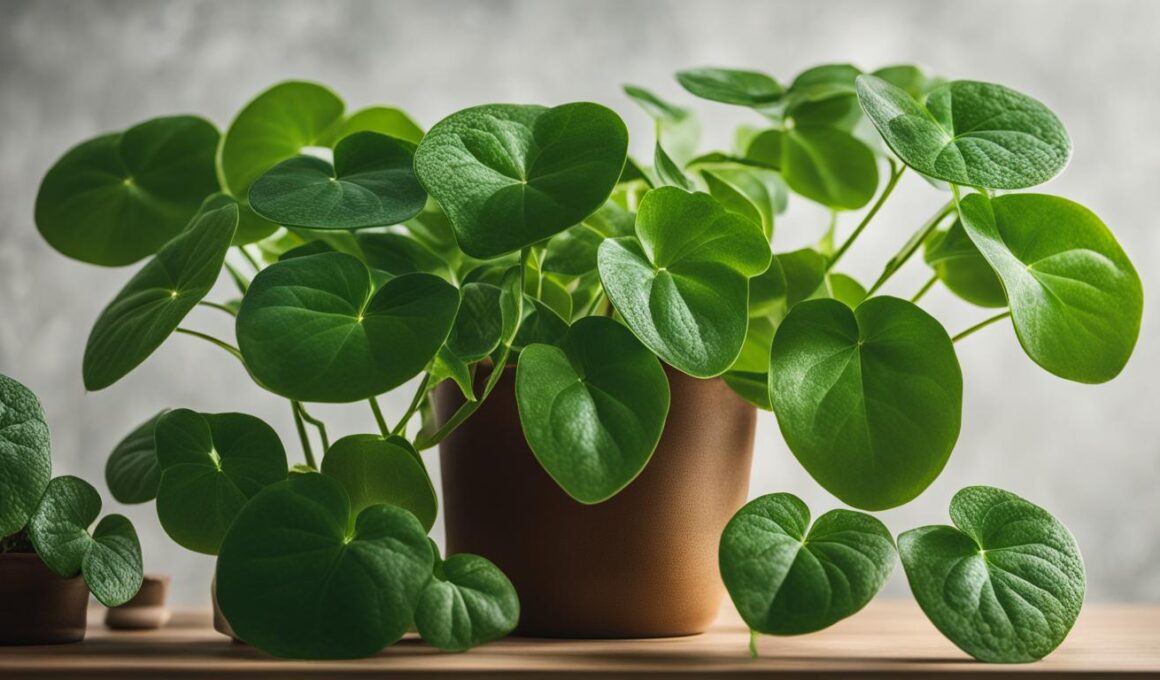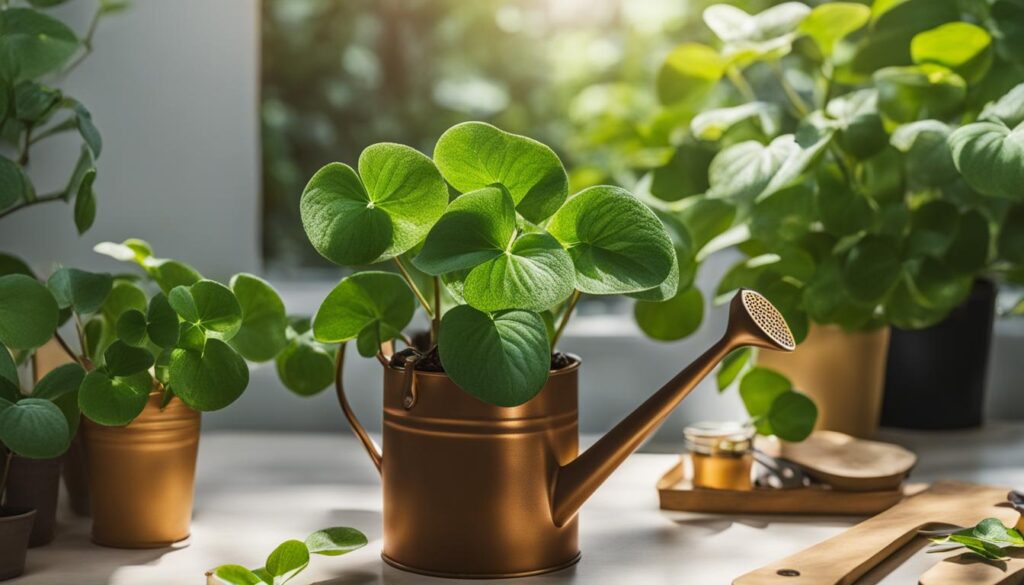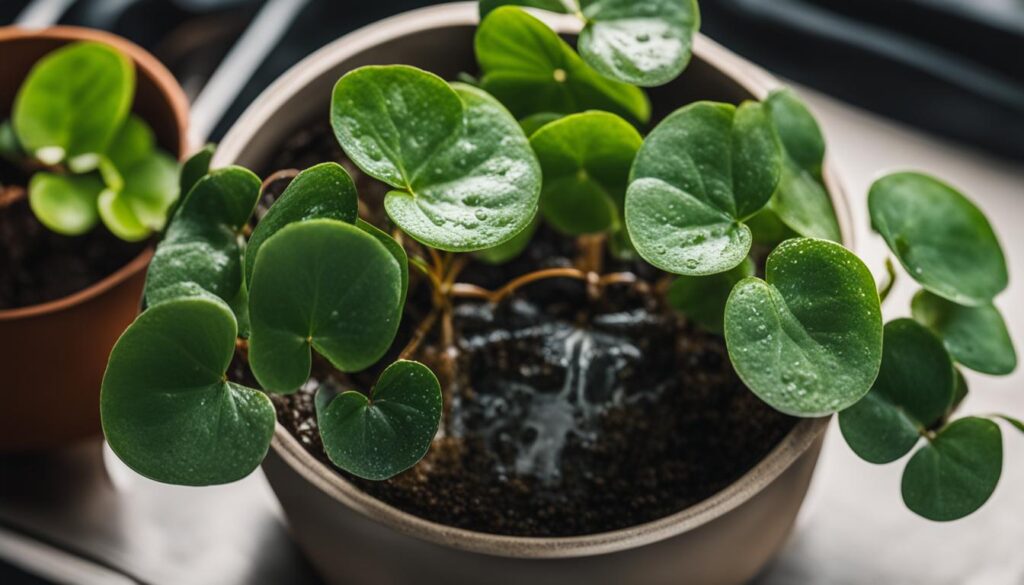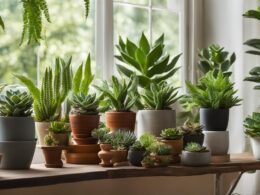As a popular and trendy houseplant, the Pilea plant is known for its vibrant green, coin-shaped leaves. However, it can be concerning when you notice your Pilea leaves turning yellow. Identifying the causes and implementing proper Pilea care can help you keep your plants healthy and thriving. In this guide, we’ll discuss the common reasons behind yellow leaves on your Pilea and the steps you can take to maintain plant health.
Key Takeaways
- Yellow leaves on Pilea plants can result from inadequate lighting, improper watering, nutrient deficiencies, or pest infestations.
- Pilea care involves ensuring bright, indirect light and a consistent watering schedule to prevent soil from being too wet or too dry.
- Proper drainage is essential for maintaining Pilea plant health and preventing root rot.
- Regularly inspecting your Pilea for pests like spider mites, scale, and mealybugs is crucial for preventing damage and maintaining the overall health of the plant.
- Fertilizing your Pilea with a general houseplant or tropical plant fertilizer can help avoid nutrient deficiencies and maintain vibrant foliage.
- Understanding and adjusting to environmental factors, such as humidity and seasonal changes, is essential for optimal Pilea care.
Understanding Pilea Plant Care Basics
As popular houseplants, Pileas are loved for their impactful foliage, but growing healthy Pileas necessitates understanding the basics of Pilea plant care and the factors that influence their overall health. To help you create an ideal environment for your Pilea, we’ve outlined the most crucial care components below:
- Light: Pileas flourish in bright indirect light, which supports their vibrant foliage and overall growth.
- Water: A consistent watering schedule that prevents the soil from being either too wet or too dry is paramount to avoid root rot and maintain moisture levels.
- Drainage: Proper drainage is crucial for Pilea plants, especially during watering, to ensure the overall health of your plant and avoid root rot.
- Fertilization: The right fertilization promotes healthy new growth and prevents nutrient deficiencies, which can exhibit as yellowing leaves.
- Environment: Factors such as humidity and seasonal changes greatly influence Pilea health and require adjustments in care routines to maintain the plants’ vitality.
By keeping these basic principles in mind, you’re on your way to growing Pileas that will thrive indoors. Now let’s dive deeper into houseplant health by exploring some of the ways you can optimize each care component for your Pilea.
| Care Component | Recommendations |
|---|---|
| Light | Place Pilea near a bright window with filtered sunlight, avoiding harsh direct sun rays that could damage foliage. |
| Water | Water when the top 1-2 inches of soil feels dry to touch. This varies based on the climate and size of your pot, so monitor closely. |
| Drainage | Select pots with drainage holes to allow excess water to escape and use well-draining soil. |
| Fertilization | Feed Pilea with a balanced liquid fertilizer every four weeks during the growing season. Dilute the solution to half strength to minimize the risk of over-fertilization. |
| Environment | Maintain a humidity level of around 50-60% and adjust watering and plant positioning as seasons change to accommodate temperature and light variations. |
Implementing these guidelines into your Pilea care routine is essential for ensuring your plants remain healthy and robust throughout their life cycle.
Watering Your Pilea: Finding the Right Balance
Proper watering is essential for maintaining healthy and vibrant Pilea plants. Overwatering and underwatering both lead to various issues such as yellowing leaves, droopiness, and stress. In this section, we will discuss the signs of overwatering and underwatering, as well as best practices for establishing an effective Pilea watering schedule.
Signs of Overwatering and Underwatering
Overwatering Pilea plants is a common mistake that can lead to yellowing leaves, root rot, and other health issues. Significant signs of overwatering include wilting leaves, soft and mushy stems, and a musty odor emanating from the soil. To prevent overwatering, you should monitor moisture levels and ensure the soil is well-draining.
| Watering Issue | Signs | Potential Problems |
|---|---|---|
| Overwatering | Wilting leaves, soft stems, musty odor | Yellowing leaves, root rot, mold |
| Underwatering | Drooping leaves, dry soil, brittle stems | Slow growth, leaf drop, weak root system |
On the other hand, underwatering signs include drooping leaves, particularly in the lower sections of the plant, dry soil, and brittle stems. An underwatered Pilea generally exhibits slow growth, leaf drop, and a weak root system. Regularly checking for soil dryness can help you avoid underwatering and maintain optimal plant health.
Best Practices for Watering Your Pilea
Establishing a suitable Pilea watering schedule will ensure your plants receive the right amount of water and maintain balanced moisture levels. Here are some best practices for watering Pilea plants:
- Monitor soil dryness by lifting the pot to check its weight, or insert a chopstick into the soil to see if it comes out dry.
- Water your Pilea when the top quarter of the soil is dry, providing consistent moisture without leaving standing water.
- Use a well-draining pot with drainage holes to prevent root rot and other issues associated with overwatering.
- Add water slowly and evenly, saturating the soil until it drains freely from the pot’s bottom.
- Discard any excess water collected in saucers or trays to prevent ‘wet feet’ and protect your Pilea’s health.
By following these best practices and maintaining a consistent Pilea watering schedule, you can ensure your plants stay healthy and vibrant, allowing them to thrive indoors.
The Role of Lighting in Pilea Plant Health
Adequate lighting plays a crucial role in maintaining healthy Pilea plants. Pileas require bright indirect sunlight, and they can benefit from the morning sun. However, excessive direct sunlight can burn their foliage, while inadequate light may cause yellowing leaves and affect their normally compact growth.
When natural light is insufficient, supplementary grow lights can be used to meet Pilea lighting needs, although they may not fully replace the sun’s intensity. Below are some guidelines to ensure optimal indirect sunlight for Pileas:
- Position your Pilea in a bright spot with filtered sunlight, such as behind a sheer curtain or in a room with bright ambient light.
- Rotate your Pilea periodically to ensure all sides receive even light exposure.
- During the summer months, move your Pilea away from intense direct sunlight, as it may cause leaf scorching.
If you do not have a suitable location or enough natural light for your Pilea, supplemental grow lights are a viable option. However, it is essential to select the appropriate type of grow light based on your specific needs and home environment.
| Type of Grow Light | Advantages | Disadvantages |
|---|---|---|
| Fluorescent | Energy-efficient, low heat output, provides a wide spectrum of light | Lower light intensity than some other options, may require a larger fixture |
| LED | High energy efficiency, long lifespan, minimal heat output, adjustable light spectrum | Higher initial cost, not as intense as high-pressure sodium lights |
| High-Pressure Sodium | High light intensity, promotes vigorous growth and flowering | Higher heat output, less energy-efficient than LEDs |
Regardless of the type of grow light you choose, ensure that it provides a full-spectrum light suitable for houseplants like Pileas. Regularly adjust its distance from your Pilea and the duration of daily exposure to find the optimal balance for your plant’s health.
Importance of Proper Drainage for Pilea Plants
Proper drainage is essential for the long-term health of Pilea plants. Ensuring that water flows through the pot is crucial for root rot prevention and overall well-being of your houseplants. A vital step in maintaining healthy drainage is using pots with drainage holes, as standing water can lead to root decay and yellowing leaves.
Preventing Root Rot with Adequate Drainage
Root rot, a common issue in houseplants, can cause severe damage to your Pilea plants. To prevent this decay, it is essential to incorporate optimal drainage and avoid overwatering.
Consider implementing these measures to achieve and maintain effective houseplant drainage:
- Choose a pot with multiple drainage holes at the bottom
- Utilize a well-draining potting soil mix, such as one that contains perlite or coarse sand
- Place a saucer under the pot to catch excess water, remembering to empty it regularly
- Monitor soil moisture levels consistently and adjust watering schedules accordingly
Additionally, note the following factors to determine if your Pilea plant is suffering from root rot:
| Sign | Indication |
|---|---|
| Yellowing leaves toward the base of the plant | Potential root rot and/or natural leaf aging |
| Mushy, soft roots | Advanced root rot |
| Unpleasant odor from the soil | Decaying roots |
| Visible mold or fungus on the soil surface or roots | Fungal infection due to overly wet conditions |
If you observe any of these signs, take immediate action to save your Pilea plant. Remove the plant from its pot, trim away any damaged or rotting roots, and repot using fresh, well-draining soil.
In summary, providing adequate Pilea drainage is indispensable for the long-term health and success of your houseplants. By implementing proper drainage practices and monitoring your Pilea plants for signs of root rot, you can prevent irreversible damage and continue nurturing a vibrant and thriving indoor garden.
Dealing with Common Pilea Pests and Diseases
Keeping Pilea plants free from pests and diseases is essential to ensuring their long-term health and preventing issues such as yellowing leaves. Common Pilea pests include spider mites, scale, and mealybugs. These insects can cause significant stress to the plant by draining essential moisture, leading to yellowing leaves and a weakened overall condition.
Regularly inspecting your Pilea for signs of infestation, maintaining clean foliage, and promptly addressing any issues are critical steps in dealing with pests and diseases. The table below shows some of the most common Pilea pests, symptoms, and treatments:
| Pests | Symptoms | Treatment |
|---|---|---|
| Spider Mites | Stippling or yellowing leaf surfaces, webbing on leaves | Remove affected leaves, wash plant with water, apply insecticidal soap or neem oil |
| Scale | Brown or white bumps on leaves, leaf yellowing and dropping | Scrape off scales with a soft toothbrush, apply insecticidal soap or neem oil |
| Mealybugs | White cottony masses on leaves and stems, leaf yellowing, and sticky honeydew residue | Dab mealybugs with alcohol-soaked cotton swabs, wash plant with water, apply insecticidal soap or neem oil |
For a more detailed yellowing leaf treatment, use targeted pest control remedies as described above and follow up with preventative measures to keep future infestations at bay.
Besides pests, fungal issues may also affect Pilea plants. Brown leaf spots can indicate fungal problems, which often arise due to excessive moisture or humidity. To prevent and treat fungal diseases, ensure proper ventilation, avoid overwatering and maintain adequate spacing between plants. A fungicide may also be applied in severe cases.
In conclusion, dealing with common Pilea pests and diseases is an essential aspect of maintaining healthy Pilea plants. Regular inspections, maintaining clean foliage, and promptly addressing any issues will help prevent the onset of plant diseases and keep your plants healthy and vibrant.
Feeding Your Pilea: Fertilization Needs and Schedule
Proper pilea fertilization is crucial for maintaining a healthy plant with vibrant foliage. Lack of nutrients in the soil may cause yellowing leaves, making it essential to provide your plant with the necessary nutrients for growth through regular feeding. With the right fertilization schedule and plant food, you can ensure your pilea receives the nutrients it needs to thrive.
Choosing the Right Fertilizer for Your Pilea
Choosing the appropriate fertilizer for your pilea is important in maintaining a nutrient-rich soil. Pileas generally require a general purpose houseplant or a tropical plant fertilizer that supports their growth and maintains the overall health of the plant. Consider the following factors when selecting a fertilizer for your pilea:
- Type of fertilizer: Whether it’s a liquid, granular, or slow-release fertilizer, each type has its benefits. Liquid fertilizers are easy to apply and quickly absorbed, while granular and slow-release fertilizers provide long-lasting nutrients to the soil.
- Nutrient ratio: A balanced fertilizer with a ratio of 10-10-10 (N-P-K) or a 20-20-20 ratio diluted to half strength is suitable for pileas.
- Organic or synthetic: Organic fertilizers release nutrients more slowly, providing a steady source of nutrition, while synthetic fertilizers are faster-acting.
Also, take note of the manufacturer’s recommendations regarding the application rates and frequencies for the chosen fertilizer. These guidelines will help ensure that your plant receives the optimal amount of nutrition without over-fertilizing.
During periods of rapid growth, especially in spring and summer, it is ideal to fertilize your pilea with every watering, adhering to the recommended dosage. As the plant’s growth slows down during fall and winter, you can gradually reduce the frequency of fertilization.
| Season | Fertilization Frequency |
|---|---|
| Spring and Summer | At every watering |
| Fall | Every two to three waterings |
| Winter | Once a month |
In conclusion, being mindful of your pilea’s fertilization needs and adhering to the appropriate schedule will go a long way in maintaining a healthy, vibrant plant. Remember to choose the right plant food and follow the manufacturer’s guidelines for optimal results. Proper fertilization will not only promote healthy growth but will also contribute to preventing yellowing leaves.
How Does Insufficient Light Affect Pilea Leaves, Resulting in Yellowing?
Pilea light requirements understanding is crucial for maintaining the health of your plant. Insufficient light can cause pilea leaves to turn yellow, affecting its overall appearance. To prevent this, place your pilea in a bright, indirect light environment and ensure it receives the recommended amount of sunlight daily.
Conclusion
In order to maintain a healthy and vibrant Pilea plant, it is crucial to understand the causes of yellowing leaves and implement prevention strategies. By managing light exposure, optimizing watering patterns, ensuring proper drainage, dealing with pests promptly, and regularly fertilizing the plant, you can create the ideal environment for your Pilea to thrive indoors.
With the right Pilea plant maintenance practices, these trendy houseplants can be an attractive addition to your indoor space, providing a lush, green atmosphere year-round. By regularly inspecting your Pilea plant for any signs of stress or imbalance, you can make adjustments to your care routine and maintain your plant’s long-term health.
Overall, taking a holistic approach to Pilea care is crucial to ensuring its well-being. By addressing all factors, from lighting and watering to pest management and fertilization, you can enjoy the unique, eye-catching foliage of these popular houseplants for years to come. Remember, a healthy and well-cared-for Pile;a is not only visually appealing, but it also contributes to cleaner indoor air and reduced stress levels.












